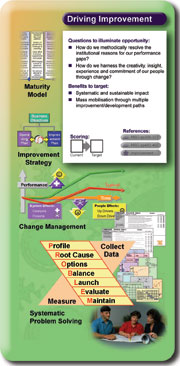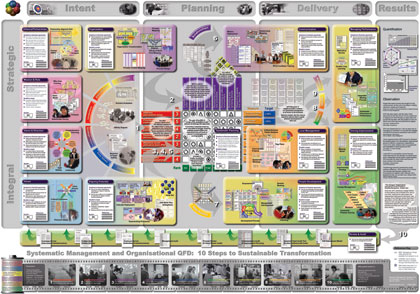Driving Improvement

![]() The process of Driving Improvement happens
at a number of different levels (both organisationally and conceptually)
and in a number of different ways - strategic/or operational;
maturity/or issue centric; performance/or potential focused;
and free-form/or discipline based. Everything about your organisation
can be improved, including the process of improvement itself.
But, while the scope of improvement is broad, and the options
appear involved and complex, the basic principles which underpin
how improvement takes place are relatively simple and straightforward
- and necessarily universal. And so, mastering a few tools provides
us with tremendouls leverage over our performance (in all respects.
The Driving Improvement panel on the right reflects some of these.
The process of Driving Improvement happens
at a number of different levels (both organisationally and conceptually)
and in a number of different ways - strategic/or operational;
maturity/or issue centric; performance/or potential focused;
and free-form/or discipline based. Everything about your organisation
can be improved, including the process of improvement itself.
But, while the scope of improvement is broad, and the options
appear involved and complex, the basic principles which underpin
how improvement takes place are relatively simple and straightforward
- and necessarily universal. And so, mastering a few tools provides
us with tremendouls leverage over our performance (in all respects.
The Driving Improvement panel on the right reflects some of these.
![]() The reduction of improvement to a few simple tools
however is in no way intended to underplay its importance. On
the contrary, the focus of everything in the big-picture (and
indeed on this website) is about driving improvement; practically
everything else you have seen here has been about structuring,
organising, and readying things so that improvement can be driven
more effectively. Improvement concerns everything, and, in its
widest sense, it is the only measure of management.
The reduction of improvement to a few simple tools
however is in no way intended to underplay its importance. On
the contrary, the focus of everything in the big-picture (and
indeed on this website) is about driving improvement; practically
everything else you have seen here has been about structuring,
organising, and readying things so that improvement can be driven
more effectively. Improvement concerns everything, and, in its
widest sense, it is the only measure of management.
![]() Success in management, then, is both defined by,
and depends on, getting a good comprehensive, systematic grip
of improvement - a grip which encompasses performance, people,
potential, processes, relationships...; which embraces both system
and creativity; which commits and controls, inspires and integrates;
which is both agile and sustained; and which (most importantly)
is demonstrably better than the competition. Everything else
in the big-picture is simply (but all-importantly) context, framework,
a precursor, a way to get this panel 'right' - without improvement,
it all means nothing!
Success in management, then, is both defined by,
and depends on, getting a good comprehensive, systematic grip
of improvement - a grip which encompasses performance, people,
potential, processes, relationships...; which embraces both system
and creativity; which commits and controls, inspires and integrates;
which is both agile and sustained; and which (most importantly)
is demonstrably better than the competition. Everything else
in the big-picture is simply (but all-importantly) context, framework,
a precursor, a way to get this panel 'right' - without improvement,
it all means nothing!
![]() Different aspects of improvement can be explored
in the Predict and Perfect
sections of the website, which also include (at the bottom of
the right hand columns) links to a number of principles to support
this, and some tools to help make it happen.
Different aspects of improvement can be explored
in the Predict and Perfect
sections of the website, which also include (at the bottom of
the right hand columns) links to a number of principles to support
this, and some tools to help make it happen.
![]() Some of these tools are reflected in the Driving
Improvement panel and are described in more detail below.
Some of these tools are reflected in the Driving
Improvement panel and are described in more detail below.
|
|
|
|
|
|
|
|
|
|
|
|
![]() Pages 356-372 of Managing
by Design can be found in Chapter
22 which can be read as a pdf file (133 KB) by clicking the
link above. Pages 482-492 concerns the use of QFD for prioritising
improvement and how it links in to other well known approaches,
and can be found in Appendix
5 and Appendix 6.
(Which can be downloaded by clicking the relevant link).
Pages 356-372 of Managing
by Design can be found in Chapter
22 which can be read as a pdf file (133 KB) by clicking the
link above. Pages 482-492 concerns the use of QFD for prioritising
improvement and how it links in to other well known approaches,
and can be found in Appendix
5 and Appendix 6.
(Which can be downloaded by clicking the relevant link).
![]() Blank templates of this panel can be found in the
Big Picture Storyboard
file - these can be used to capture your own experiences and
progress in this area (by annotating them either in PowerPoint,
or as a printed panel), and then to physically cut and paste
them onto the Big Picture to create your own storyboard of implementing
systematic management in your organisation.
Blank templates of this panel can be found in the
Big Picture Storyboard
file - these can be used to capture your own experiences and
progress in this area (by annotating them either in PowerPoint,
or as a printed panel), and then to physically cut and paste
them onto the Big Picture to create your own storyboard of implementing
systematic management in your organisation.
To explore another secion of the big picture, please click on the relevant area of the image below:
© Tesseract Management Systems Ltd 2006
(click below for an oversight)
Get your own Big Picture
(Purchase the Big Picture as a high quality wall chart)
The best systematic resources now available.
(tools and methodologies)
Testimonials on systematic management
|
|
|
|
|
|
|
|
|
|
|
|
|
|
|
|
|
|
|
|
|
|
|
|
|
|
|
|
|
|
